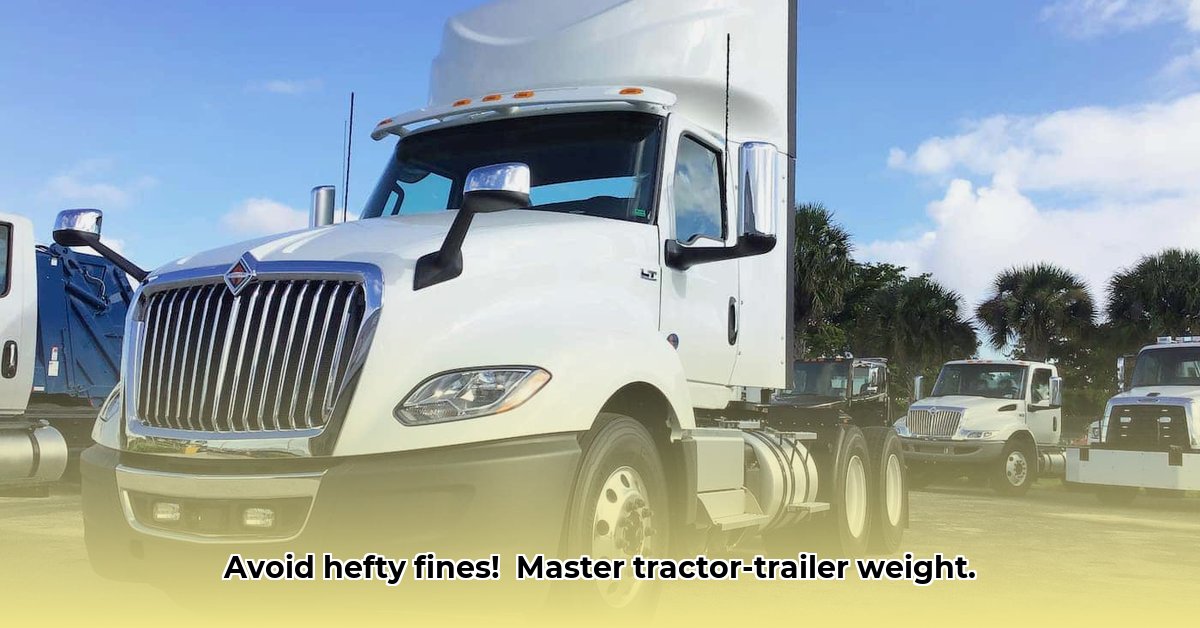
Understanding Tractor-Trailer Weights: A Comprehensive Guide
Knowing the weight of your tractor-trailer combination is crucial for safety and legal compliance. This guide provides a clear understanding of the factors influencing weight, helping you avoid fines and ensure safe operation. We'll cover everything from calculating average weights to navigating weigh stations effectively. For more detailed weight information, see this helpful guide: Tractor Trailer Weights.
Decoding the Weight Components
The total weight isn't simply the cargo's weight. It's the sum of the tractor, trailer, and cargo. A heavier-duty tractor will weigh more than a lighter model, and a refrigerated trailer ("reefer") is heavier than a standard dry van. Cargo type significantly impacts weight; steel weighs far more than pillows. Therefore, an exact average is difficult to define. We'll explore typical ranges, but remember: each trip is unique. Did you know that even the type of fuel in your tanks impacts the overall weight? Accurate measurement is always best.
Federal and State Weight Regulations: A Complex Landscape
The federal government sets a maximum Gross Vehicle Weight Rating (GVWR) – the total weight of a fully loaded vehicle – at 80,000 pounds. However, many states impose lower limits due to infrastructure concerns. Checking specific state and route regulations before each journey is paramount. Failure to do so can result in significant fines and delays. Ignoring weight limits poses serious safety risks, potentially leading to accidents and infrastructure damage. What are the specific weight limits for your next route?
Weight Distribution and Axle Configuration: The Importance of Balance
Proper weight distribution is as critical as staying within legal limits. Uneven weight impacts handling, braking, and increases the risk of jackknifing. Understanding how weight is distributed across axles is essential for control and safety. This involves careful cargo placement, ensuring even pressure across all axles. How can you ensure optimal weight distribution on your next haul?
Safe Loading Practices: A Step-by-Step Guide
Safe loading techniques are crucial for preventing accidents and legal compliance. Follow these steps:
- Weigh Your Cargo: Always use a certified scale to determine the exact weight before loading. Avoid estimations; accuracy is vital.
- Even Distribution: Strategically position the payload to distribute weight evenly across the trailer. Avoid concentrating heavy items in one area.
- Secure Your Load: Use appropriate straps, chains, or other securing devices to prevent shifting during transit. A shifting load is extremely dangerous.
- Weigh-in-Motion: Many trucks have onboard scales providing real-time weight readings. Use these to verify compliance.
- Documentation: Maintain detailed records of weight, cargo details, and load-securing methods.
Navigating Weigh Stations: Preparation is Key
Weigh stations enforce weight regulations. Preparation ensures a smooth experience. Ensure your paperwork is organized, you understand your weight limits, and you're familiar with weigh station procedures. Overweight loads will result in delays, fines, and potential unloading. What are the most common reasons for weight-related violations at weigh stations?
Technology and Weight Management: Streamlining the Process
Modern technology enhances weight management. Onboard scales offer real-time feedback, allowing adjustments. Route-planning software optimizes routes based on weight and other factors. These tools improve safety and efficiency. What technological advancements are currently improving weight management in the trucking industry?
Typical Weight Ranges: A Quick Reference Guide
The following table shows estimated weight ranges. Remember, these are averages; actual weights vary significantly.
| Tractor Type | Trailer Type | Approximate Empty Weight (lbs) | Approximate Loaded Weight (lbs) |
|---|---|---|---|
| Class 8 Heavy | Dry Van | 30,000 - 40,000 | 60,000 - 80,000 |
| Class 8 Heavy | Reefer | 35,000 - 45,000 | 65,000 - 80,000 |
| Class 7 Medium | Flatbed | 25,000 - 35,000 | 50,000 - 70,000 |
Important Note: These are estimates and can vary substantially.
Conclusion: Prioritize Safety and Compliance
Compliance isn't just about avoiding penalties; it's about safety. Understanding average tractor-trailer weight and safe loading practices is essential for responsible trucking. Continuous learning and staying updated on regulations are crucial. What steps can you take today to improve your weight management practices?
Resources
- Federal Motor Carrier Safety Administration (FMCSA)
- Your State's Department of Transportation